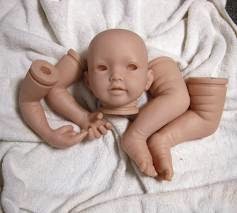The dolls were painted with the idea of adding realistic colors but also making the skin soft and touchable as a real baby's. They added glass eyes, real hair and eyelashes. Nothing was left out. The babies could take a pacifier (often stuck on with a strong magnet) and have a fake (or faux) bottle with no hole.
They wore real Pampers and tiny baby clothes. booties. bracelets and headbands. These were wrapped in blankets, some coming from hospitals, with wristband and even oxygen tubes. During stuffing, the body was weighted with pellets or glass beads so the butt and head were as heavy as a real baby's. The dolls were cuddly and soft, a bit floppy (hold the head securely) so they felt as if one was cradling a real child in one's arms. Many of the models were of sleeping newborns (less than 20 inches long) that caused cops to react when they found one in a closed car.
These dolls, ranging in price from over $100 to $2,000, were not toys for children, but collectibles for adults who could afford them and give them the care and clothing they needed.To display them properly one had to buy a stroller, bouncing chair or even a crib. Complete rooms were made into nurseries for the reborns.
In October 2014 I got my first one.
I picked her for her smile and bright eyes which looked so much as my firstborn, Heidi, did at birth. I asked Heidi what name she would have chosen if she wasn't Heidi and she said, "Jenny Wren" a name my mother had called me. So this baby is a combination of the baby-hoods of Heidi and myself. This photo is of Jenny under the Christmas tree with her nanny, one of my Steif tigers.
Jenny in her new stroller with a new outfit and her beaded monkey friend. Werner suggested she might want to listen to music during the long nights we left her alone in the living room. That oreo cookie in her lap is crocheted! - no crumbs.






No comments:
Post a Comment